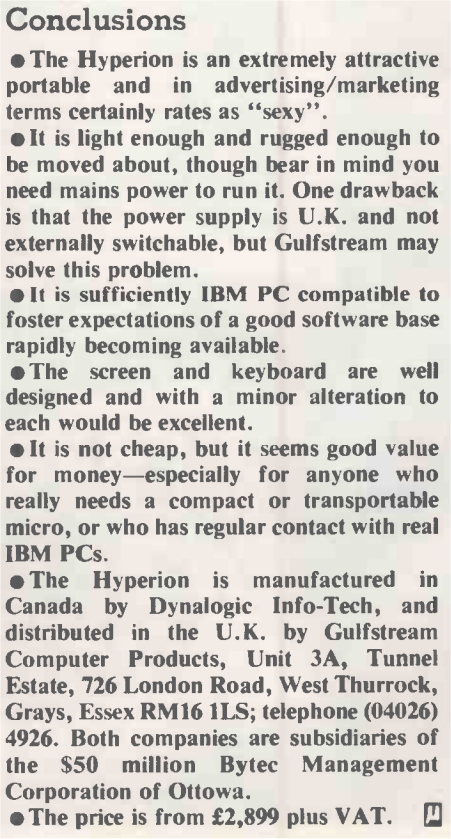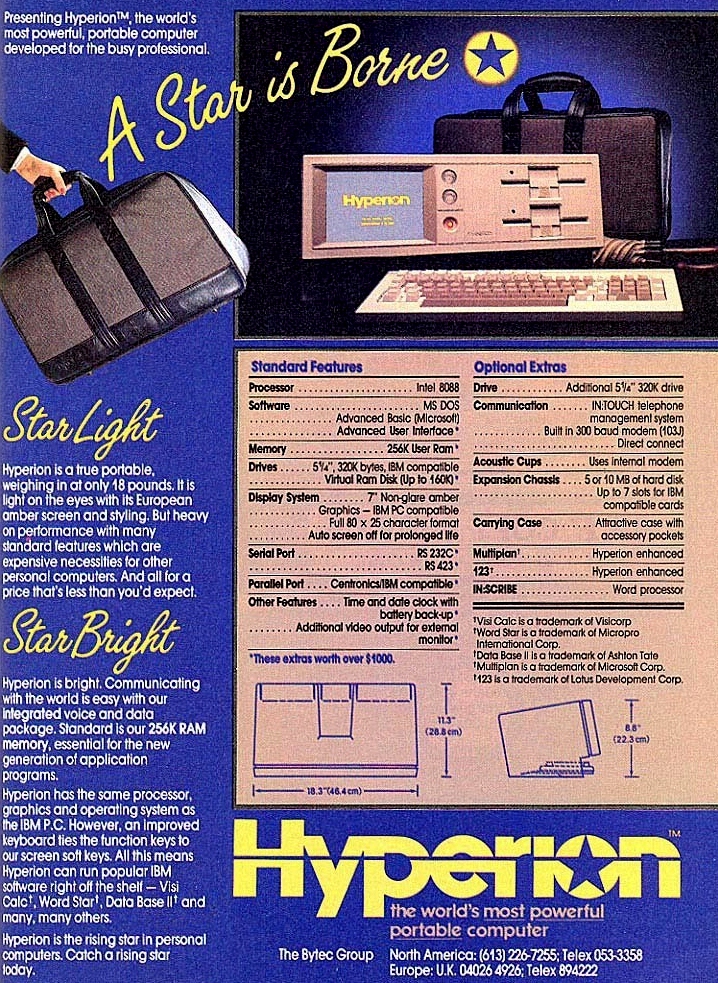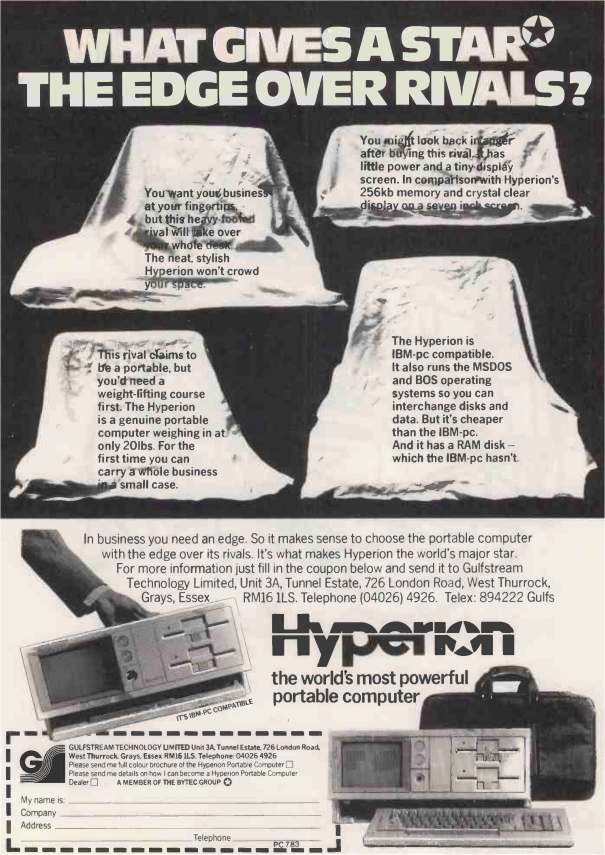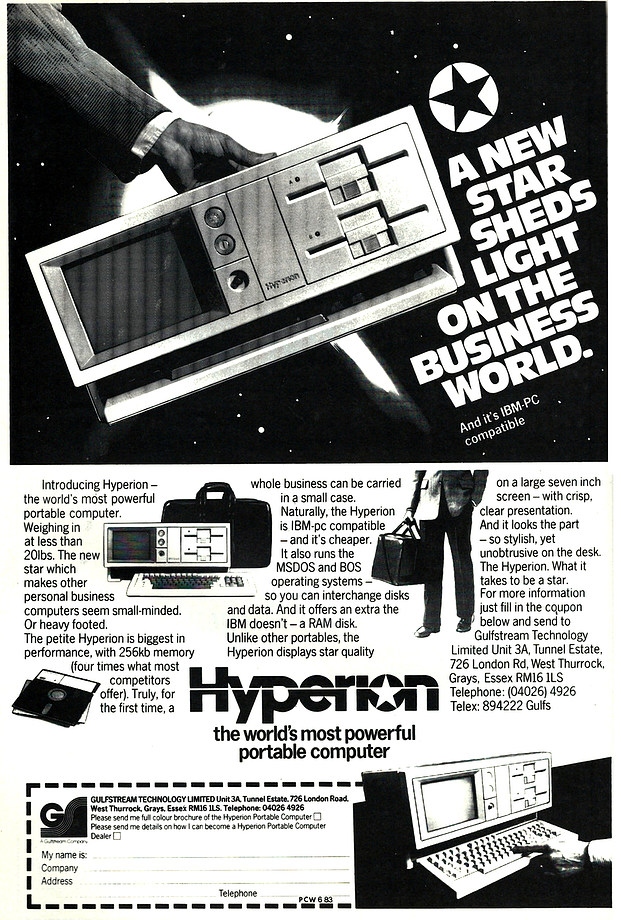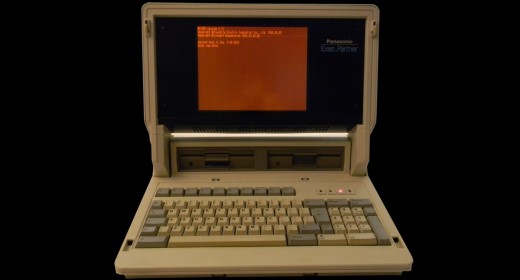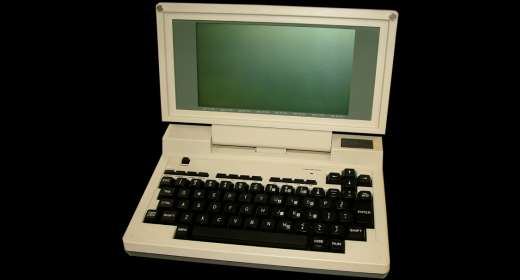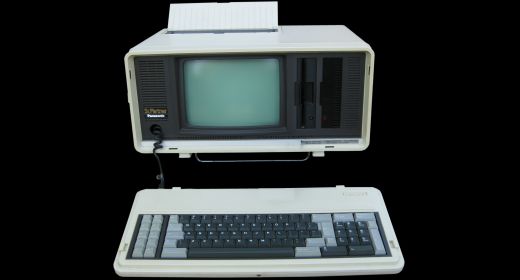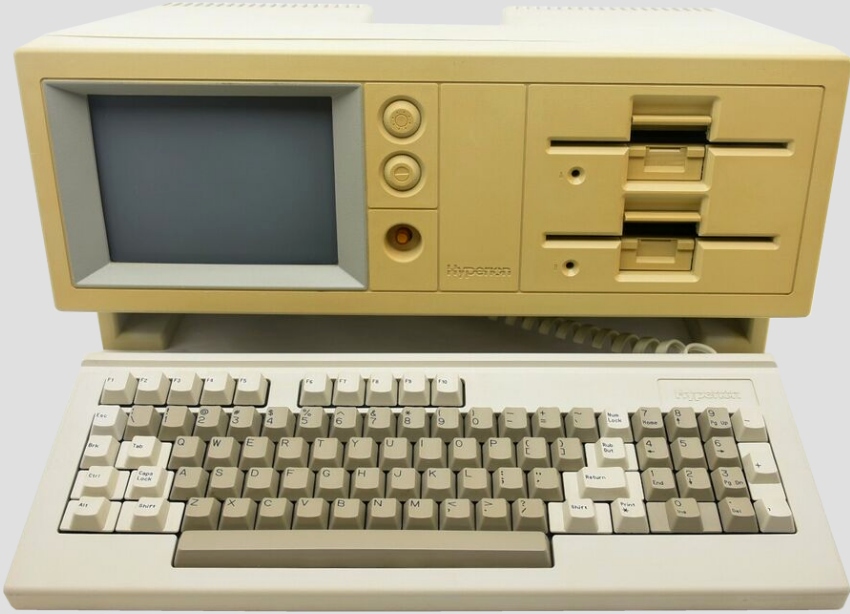
The Dynalogic Hyperion portable computer was an early and innovative entry in the emerging market for luggable PCs in the early 1980s. Developed by the Canadian company Dynalogic and first unveiled at the 1982 Spring COMDEX trade show, the Hyperion beat the launch of the popular Compaq Portable by a few months to become the first IBM PC compatible portable computer available.
The Hyperion had a retail price of $4555 for the complete system including the modem. It featured an Intel 8088 16-bit CPU running at 4.77 MHz along with 256KB of RAM, comparable to typical desktop PCs of the period. For storage, it had two built-in 5.25 inch floppy disk drives with 320KB capacity each. The computer weighed about 21 pounds and measured 8.8 x 18.3 x 10 inches, making it compact enough to carry using a handle on the top. This made it one of the earliest examples of a “luggable” portable personal computer, though it still required an AC power connection to operate.
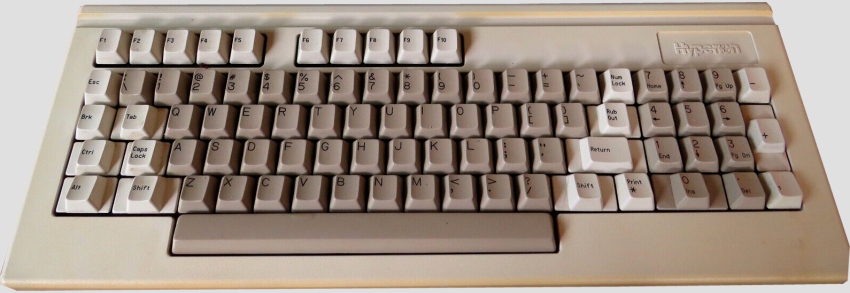
The Hyperion’s design emphasized usability with well-placed controls and an ergonomic keyboard layout. The front of the main unit features two thumbwheels for easy adjustment of the screen’s brightness and contrast levels. Status lights indicate when the power is on and the floppy disk drives are active. The outer shell is finished in an attractive cream color with a texture resembling IBM’s desktop PC models.
The detachable keyboard was more compact than the IBM PC keyboard but retained a full 83-key layout. Several keys were repositioned to improve the typing experience compared to the IBM model. For example, the backslash key was moved to the top row while the Alt key shifted to the left side. Additionally, the 10 software-programmable function keys lined up directly beneath their menu labels displayed at the bottom of the screen. This made the system’s unique menu-driven software easier to use.
While lightweight and functional, the keyboard’s tight coiled cable connection to the right side constrained usability. On smooth surfaces, the keyboard could shift sideways while typing. Placing the keyboard on one’s lap required holding it steady with the other hand. Unfortunately, the cable was hardwired without the option to detach and replace it with a different style connector. This limited the keyboard’s range and mobility despite its wireless design. The keyboard stows away underneath the main computer housing.
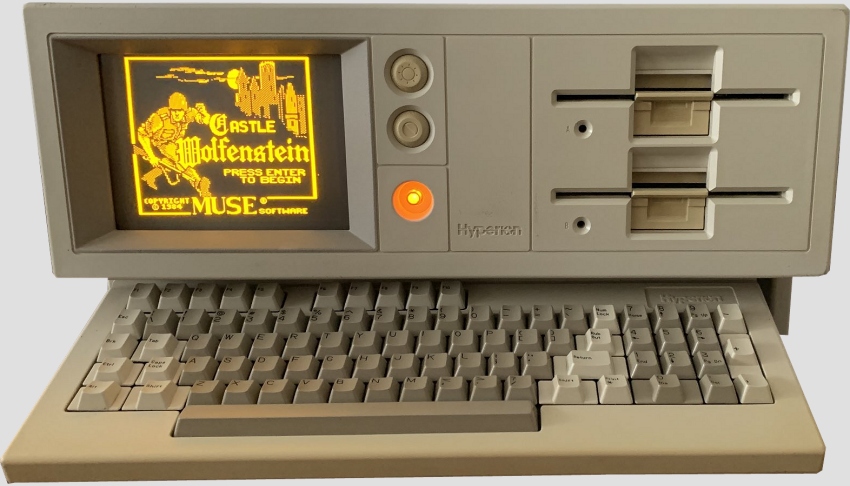
An internal 300 baud modem was also an option for dial-up communications. For display, the Hyperion had a built-in 7 inch amber CRT monitor capable of text display with 80 columns by 25 rows. It also supported CGA compatible 320×200 color graphics as well as monochrome 640×200 graphics.
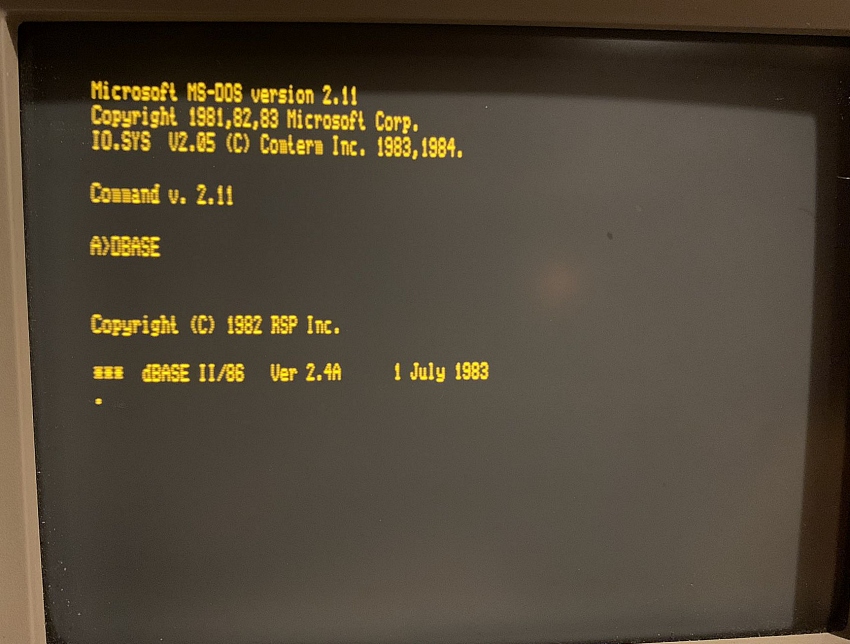
On the software side, the Hyperion ran Microsoft’s MS-DOS operating system to provide IBM PC compatibility. It also included Microsoft Multiplan and BASIC programming packages. Uniquely, it featured two custom programs for the system called InScribe and InTouch. InScribe was a text editor that made heavy use of function keys to access menus and commands. InTouch provided a suite of tools for managing file transfers and communications over the internal modem.
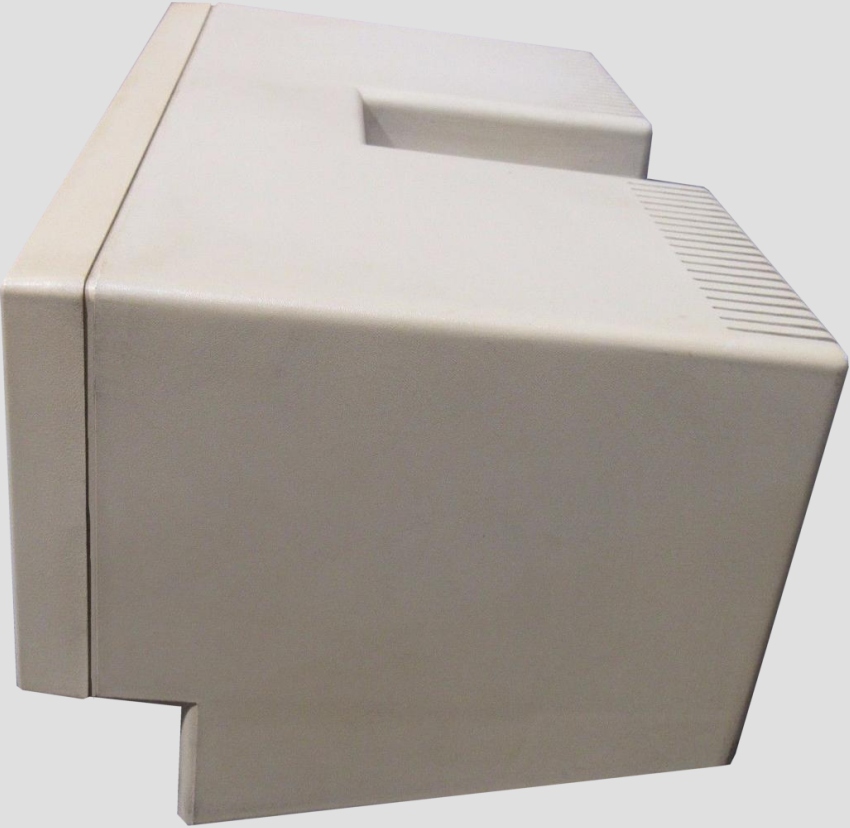
In terms of compatibility with the IBM PC, the Hyperion was designed to run the same software and access the same data files. However, there were some differences in the underlying hardware that caused occasional issues. For example, the video display controller and serial port interfaces used different integrated circuits. This meant some software that directly accessed the PC’s hardware would fail to run properly on the Hyperion. Still, its high degree of compatibility allowed it to run most of the popular business applications of the time.
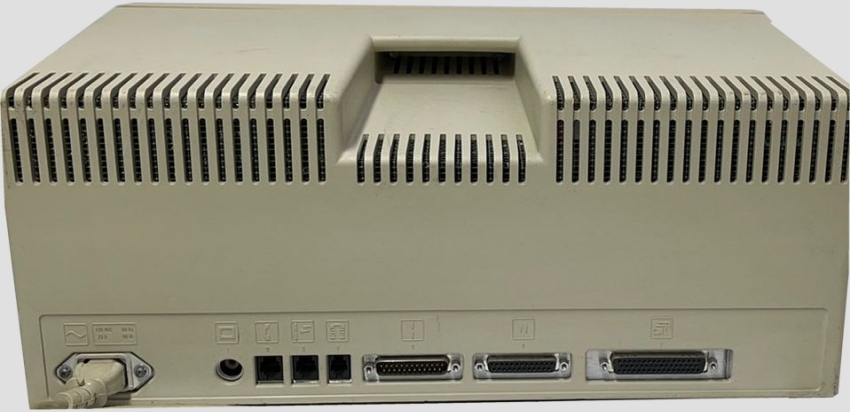
The mains power input and all the I/O ports are on the back. They are identified with symbols and clearly numbered as
follows:
- 1 – Composite video jack for external monitor
- 2 and 3 – Direct -connect telephone jacks with built-in auto -answer Modem
- 4 – Port for connecting to an acoustic coupler if phone jacks not available
- 5 – Serial interface port
- 6 – Parallel interface port
- 7 – Expansion bus
The Hyperion’s built-in ports and connections gave it the capability to interface with a wide range of peripherals that met RS-232 and RS-423 communication standards. This included support for both synchronous and asynchronous transmissions. Through its DE9 connector, it could connect to most common printers of the era. Additionally, the Hyperion had a 50-pin female socket that carried all of the computer’s output lines. While not utilized on the base system, this versatile interface could potentially be used for external devices like hard disk drives or networking hardware that would expand the Hyperion’s capabilities. The company planned to take advantage of this socket to offer a hard drive option in the future.
Here is what Practical Computing said of the Dynalogic Hyperion after testing it in 1983:
When it debuted, the Hyperion was met with enthusiasm and seen as an impressive achievement in packing desktop PC functionality into a portable form factor. Initial orders were strong, with nearly $25 million in backorders within the first year. Its combination of power and portability made it appealing for business users who wanted access to computing on the go. Reviewers at the time praised many of the Hyperion’s features like its sharp display, capable bundled software, and well-designed keyboard.
Features:
- Intel 8088 16-bit CPU
- 256K RAM
- Two built-in 5 1/4-inch floppy disk drives, 320K each
- 8088 bus connection for future Winchester hard disk systems
- Standard keyboard (83 keys), managed by its own 8049 microprocessor and with a built-in 16 character buffer
- Seven-inch (diagonal) CRT with 80-column by 25-line display
- Built-in serial RS-232C and Centronics parallel printer interfaces Battery-backed calendar clock
- MS-DOS operating system
- 115 V ac operation
- IBM PC compatible
Software:
- Microsoft’s MS-DOS, Multiplan and Basic A
- Dynalogic’s InScribe (a system editor) and InTouch (a telecommunications manager)
- A version of UCSD Pascal.
Options and Accessories:
- Internal 300-baud modem (auto-answer, autodial)
- Winchester hard disk system.
However, the Hyperion soon faced criticism about its reliability issues, especially with its floppy disk drives. Manufacturing defects led to a number of warranty claims that hurt Dynalogic. It also suffered from documentation that was viewed as confusing and difficult to use properly. Most significantly, the release of the Compaq Portable overshadowed the Hyperion’s capabilities. The Compaq was more fully compatible with the IBM PC hardware and software, giving it an edge with business customers.

The Hyperion had a short market life of only about two years before being discontinued in 1984. While Dynalogic estimated it lost $48 million on the project, the Hyperion still holds an important place in the history of portable computing. It pioneered the “luggable” category between heavy desktop PCs and the lighter laptops that would arrive later. The Hyperion also stands out as one of the few PC innovations to emerge from Canada during the rapid growth of the personal computer industry in the 1980s. While it was overtaken by the overwhelming success of the IBM PC and Compaq compatibles, the Dynalogic Hyperion demonstrated the potential for portable computing early on.
